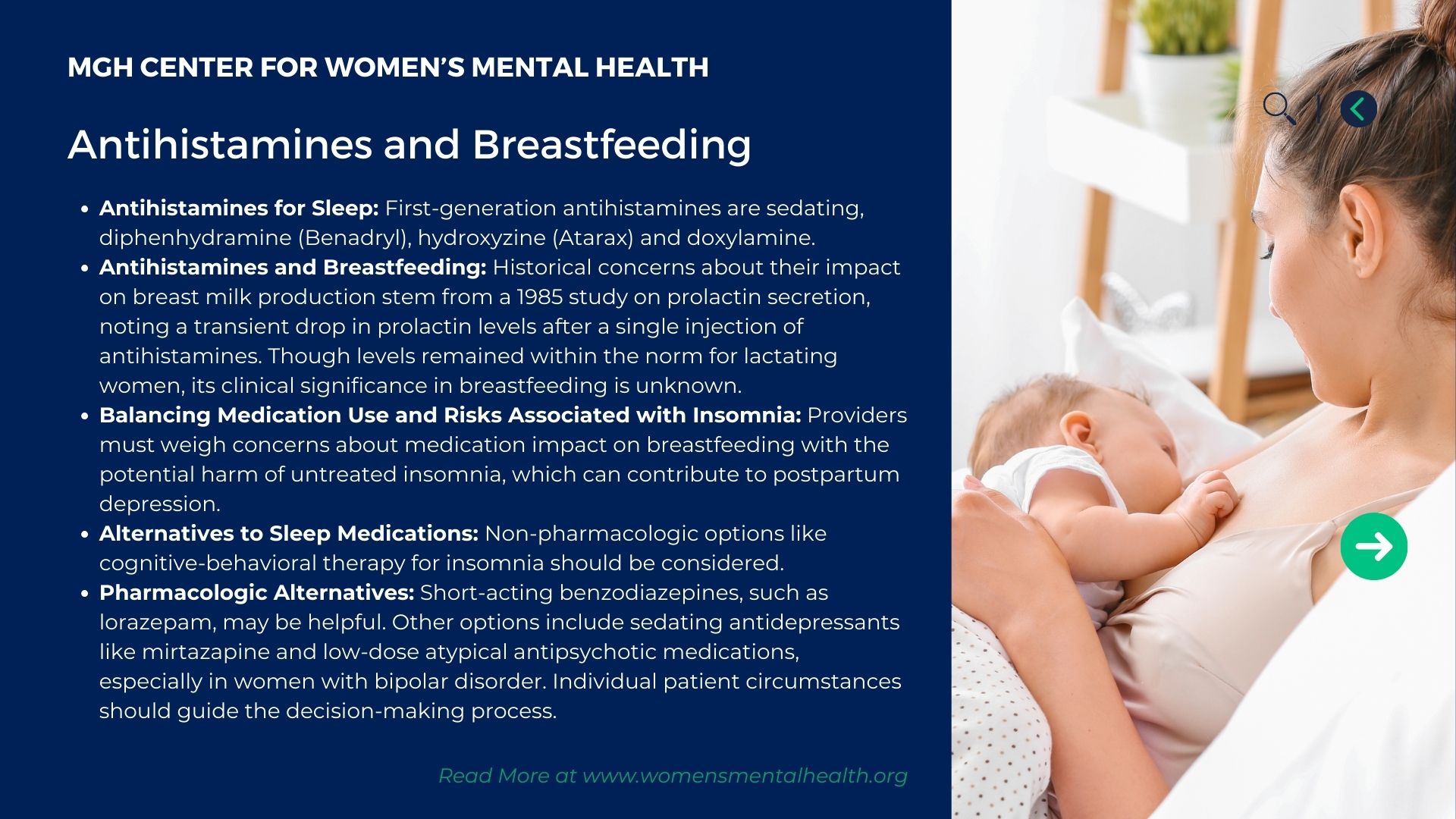First-generation antihistamine medications are used to treat allergic reactions but are also often used as sleep medications due to their ability to promote sedation by binding to histamine receptors in the brain. While second-generation antihistamines, like loratadine (Claritin) are not sedating, first-generation antihistamines, such as diphenhydramine (Benadryl), hydroxyzine (Atarax) and doxylamine, exhibit sedative effects through antagonism at H1 histamine receptors in the brain.
Other medications commonly used for their sedating effects also interact with histamine receptors. Doxepin is a tricyclic antidepressant that binds to H1 histamine receptors at low doses and is sometimes used to promote sleep. Trazodone may also produce sedation through its actions as an antagonist at the H1 histamine receptor.
Sleep disruption and insomnia are commonplace among postpartum women, and they often ask what medications are compatible with breastfeeding. With regard to sedating antihistamines, patients are often told to avoid these medications because they may reduce breast milk production.
Antihistamines and Milk Production: What’s the Evidence?
When a woman is planning and feels the pressure to breastfeed, taking a medication that may reduce milk production is obviously a concern. But what’s the evidence?
No studies have actually investigated the effects of these medications on breast milk production directly. This prohibition on the use of first-generation antihistamines by breastfeeding women comes from a single paper published in 1985. This study focused on the effects of first-generation antihistamines on prolactin secretion. In postpartum women, prolactin stimulates milk production; levels of this hormone rise during pregnancy, peak at the time of delivery (rising to about 200 mg/ml), and continue to be elevated in lactating women (typically above100 mg/ml).
In this pharmacokinetic study, researchers analyzed serum prolactin levels after a single injection of two different antihistamines, 100?mg promethazine or 20?mg chlorpheniramine, in postpartum women one day after delivery. Prolactin concentrations decreased by about 50% during the first 30?minutes after the injection of promethazine but then increased again over time. Although there was a transient reduction in prolactin levels, those levels continued to be high (above 100 mg/ml) and in the range of what is normally observed in lactating postpartum women.
No studies have systematically assessed the effects of these antihistamines on breastfeeding in postpartum women. Nor do we have adequate information to definitively comment on the impact of first-generation antihistamines on milk production. However, it is assumed that a transient reduction in serum prolactin levels will have no clinically significant effect on breast milk production because prolactin levels increase once lactation is established.
Avoiding or Stopping Sleep Medications Also Carries Risk
While it is understandable to avoid medications that may decrease milk production, we must take into consideration the effects of untreated insomnia in the mother. Sleep deprivation can significantly affect well-being and capacity to function effectively. There is also a growing body of literature to indicate that insomnia and poor sleep quality may increase risk for postpartum depression.
Research regarding the use of sedating antihistamines in breastfeeding women is limited. While the use of sedating antihistamines may transiently decrease prolactin levels, what we know about prolactin and breastfeeding suggests that using a sedating antihistamine in this setting at standard doses is unlikely to have a clinically significant impact on breastfeeding.
Nonetheless some may not feel comfortable using this class of medications in women planning to breastfeed. If these sleep aids are not an option, we must consider other alternatives. Cognitive-behavioral therapy for insomnia is a non-pharmacologic option, although adherence to this type of therapy may be difficult when caring for a newborn.
Other pharmacologic options include benzodiazepines. Research is limited but indicates a low risk of adverse events in nursing infants. Short-acting benzodiazepines, such as lorazepam, may be preferable as they promote sleep but have diminishing effects over the next few hours and are less likely to interfere with waking. At our clinic, this is generally our first choice for individuals with no history of substance use disorder.
In our clinic, we do not typically use sedative-hypnotics, such as zolpidem (Ambien), in this setting. Their behavior is less predictable and have been associated with sleepwalking and other sleep-related activities.
Mirtazapine (Remeron) is a sedating antidepressant and may also be used in this setting. According to data collected by Lactmed, the risk of adverse events in nursing infants appears to be low.
We may also use sedating atypical antipsychotic medications in this setting, including low-dose olanzapine (Zyprexa) and quetiapine (Seroquel). This is a particularly important option in women with documented or suspected bipolar disorder.
Ruta Nonacs, MD PHD
Ngo E, Spigset O, Lupattelli A, Panchaud A, Annaert P, Allegaert K, Nordeng H. Antihistamine use during breastfeeding with focus on breast milk transfer and safety in humans: A systematic literature review. Basic Clin Pharmacol Toxicol. 2022 Jan;130(1):171-181.









Leave A Comment